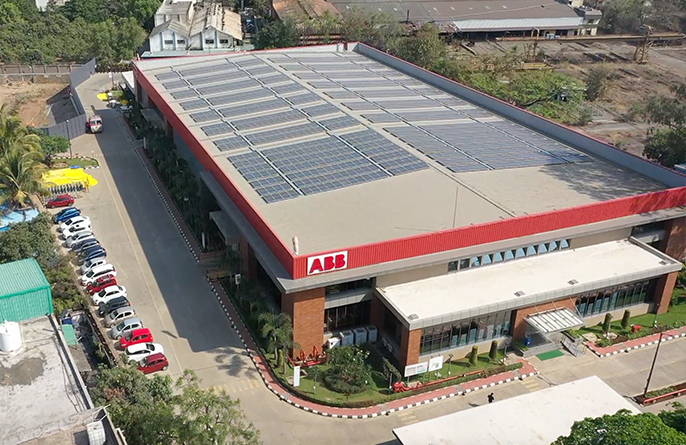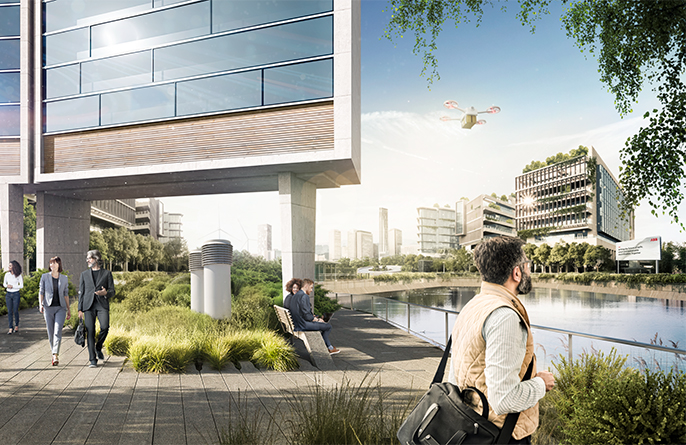ABB emissions Achieving carbon neutrality across our operations
Target: By 2030, we will achieve carbon neutrality across our own operations
We have committed to neutralizing ABB’s carbon footprint by 2030. From 2019 to 2021, we already reduced our own GHG emissions by 39 percent. In 2021, we reduced our GHG emissions by 28 percent. Our 2019 baseline for our Scope 1 and 2 GHG emissions was 668 kilotons, and we have already identified areas where we can reduce these direct and indirect emissions by at least 80 percent by 2030. These areas include the use of renewable energy, electrifying our entire vehicle fleet, and implementing energy-efficiency measures at our sites. Further solutions for the remaining emission will be explored. In the event that no other solutions are found, we will look for appropriate offset options.
In 2021, we worked to translate ABB’s target of carbon neutrality in our own operations and our commitments to the EV100, RE100 and EP100 initiatives, among others, into specific programs and KPIs, for implementation by our Group’s Business Areas and Divisions. In addition, we created an ABB-wide carbon emissions baselining and forecasting roadmap, which sets forth expected progress on a year-by-year basis at a granular level.
Mission to Zero sites
Mission to Zero sites
In 2021, we continued to improve the energy efficiency of ABB sites around the world. More than 100 energy-efficiency projects were implemented in 2021 across ABB, saving 17.5 GWh of energy. Additional energy reviews and audits at both the Business Area level and Group level are underway or scheduled. The results will be used to implement operational and infrastructure changes to reduce energy consumption. Related projects include installing energy management and monitoring systems, building on-site capacity to generate renewable energy, upgrading motors and drives, making changes to production processes and simply upgrading to LED lighting. Also in 2021, the ABB Real Estate function’s energy savings program reaped a total of 83.5 GWh per year and $18.5 million in savingsThe reported figures should be considered as an indication of the potential impact resulting from EE-projects within ABB worldwide and not as resulting from project-specific measurement and verification (M&V) activities. between 2018 and 2021 from 243 completed, ongoing and planned energy-saving projects in ABB buildings worldwide. Even considering the decreasing emission intensity of the energy purchased globally by ABB, these projects enable us to cut our GHG emissions by 22.2 kilotonsRegardless of the related energy source, the CO2 emissions resulting from energy savings are estimated at a given emission intensity of 0.266 kilotons CO2 per GWh – the average emission intensity of the ABB Group in 2020 (Source: ABB Sustainability Report 2020). per year.
ABB electricity consumption and share of green electricity in 2021
ABB electricity consumption and share of green electricity in 2021
The process of electrifying vehicle fleets across our Group is well underway. ABB is on track to fulfill its commitment to the EV100 initiative to electrify its fleet of more than 10,000 vehicles by 2030, with actions currently ongoing across the world, including Sweden and the United Kingdom. In 2021, 44 percent of ABB’s global new vehicle orders were for either EVs or plug-in hybrid vehicles (PHEVs).
Sweden and United Kingdom fleet conversion
Sweden and United Kingdom fleet conversion
Our direct emissions of GHGs from on-site handling of sulfur hexafluoride (SF6), as well as leakage of SF6 from our production processes, were also addressed in a dedicated, global program. In total, we reduced ABB’s direct emissions of SF6 by 32 percent over the past year. In 2021, we emitted 2.21 tons of SF6, down from 3.26 tons in 2020.

